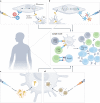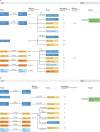COVID-19 vaccines in patients with cancer: immunogenicity, efficacy and safety
- PMID: 35277694
- PMCID: PMC8916486
- DOI: 10.1038/s41571-022-00610-8
COVID-19 vaccines in patients with cancer: immunogenicity, efficacy and safety
Abstract
Patients with cancer have a higher risk of severe coronavirus disease (COVID-19) and associated mortality than the general population. Owing to this increased risk, patients with cancer have been prioritized for COVID-19 vaccination globally, for both primary and booster vaccinations. However, given that these patients were not included in the pivotal clinical trials, considerable uncertainty remains regarding vaccine efficacy, and the extent of humoral and cellular immune responses in these patients, as well as the risks of vaccine-related adverse events. In this Review, we summarize the current knowledge generated in studies conducted since COVID-19 vaccines first became available. We also highlight critical points that might affect vaccine efficacy in patients with cancer in the future.
© 2022. Springer Nature Limited.
Conflict of interest statement
E.G.E. de V has acted as an advisor and/or consultant to Crescendo Biologics, Daiichi Sankyo and NSABP, declares financial support for clinical trials and/or contract research from Amgen, Bayer, Crescendo Biologics, G1 Therapeutics, Genentech, Regeneron, Roche, Servier and Synthon, and declares unpaid roles as a co-chair of the RECIST committee, as a chair of the ESMO Cancer Medicines Committee, as a member of the ESMO-MCBS working party, as a member of the expert panel for the selection of Essential Medicines List WHO, as a member of the Royal Netherlands Academy of Arts & Sciences and as a member of the supervisory board of the Netherlands Comprehensive Cancer Organization, and is a Project leader of the ZOnMw-funded Vaccination against cOvid In CancEr (VOICE) study. J.B.H. has acted as an advisor to Achilles Therapeutics, AstraZeneca, Bristol Myers Squibb, BioNTech, Immunocore, Ipsen, Instil Bio, Iovance Bio, MSD, Merck Serono, Molecular Partners, Novartis, Neogene Therapeutics, Pfizer, Roche/Genentech, Sanofi and T-Knife, has received research funding from Asher Bio, Amgen, Bristol Myers Squibb, MSD, BioNTech, Neogene Therapeutics and Novartis, has stock options in Neogene therapeutics, and is the current Editor-in-Chief of ESMO Immuno-Oncology and Technology. S.T. has received speaker’s fees from AstraZeneca, Ipsen, Novartis and Roche, and is listed on the following patents: Indel mutations as a therapeutic target and predictive biomarker (PCTGB2018/051892 and PCTGB2018/051893, as inventor) and Clear Cell Renal Cell Carcinoma Biomarkers (P113326GB, as co-inventor). M.v.L.T. has received speaker’s fees from Abbvie, Amgen, AstraZeneca, BMS, CDDF, Celgene, Chugai, GSK, Gilead, Janssen, Medac, Merck, Novartis, Oncopeptides, Pfizer, Shionogi, Takeda and Thermofisher, and research funding from BMBF, Celgene, Deutsche Jose Carreras Leukämie-Stiftung, Deutsche Krebshilfe, DFG, Gilead, IZKF Jena, Novartis and Oncopeptides. A.F., C.H.G., and B.W. declare no competing interests.
Figures


References
Publication types
MeSH terms
Substances
Grants and funding
- FC001078 /WT_/Wellcome Trust/United Kingdom
- FC001099 /WT_/Wellcome Trust/United Kingdom
- 29911/CRUK_/Cancer Research UK/United Kingdom
- FC001078 /CRUK_/Cancer Research UK/United Kingdom
- FC001988 /MRC_/Medical Research Council/United Kingdom
- FC001169/WT_/Wellcome Trust/United Kingdom
- FC001218 /MRC_/Medical Research Council/United Kingdom
- FC001030 /WT_/Wellcome Trust/United Kingdom
- FC001099/WT_/Wellcome Trust/United Kingdom
- FC001218/WT_/Wellcome Trust/United Kingdom
- FC001218 /WT_/Wellcome Trust/United Kingdom
- FC001030 /MRC_/Medical Research Council/United Kingdom
- FC001030 /CRUK_/Cancer Research UK/United Kingdom
- FC001169 /CRUK_/Cancer Research UK/United Kingdom
- FC001169 /MRC_/Medical Research Council/United Kingdom
- FC001002 /WT_/Wellcome Trust/United Kingdom
- FC001099 /CRUK_/Cancer Research UK/United Kingdom
- FC001988/WT_/Wellcome Trust/United Kingdom
- FC001002 /MRC_/Medical Research Council/United Kingdom
- FC001030/WT_/Wellcome Trust/United Kingdom
- FC001099 /MRC_/Medical Research Council/United Kingdom
- FC001988 /CRUK_/Cancer Research UK/United Kingdom
- FC001078 /MRC_/Medical Research Council/United Kingdom
- FC001002/WT_/Wellcome Trust/United Kingdom
- FC001078/WT_/Wellcome Trust/United Kingdom
- C50947/A18176/CRUK_/Cancer Research UK/United Kingdom
- FC001169 /WT_/Wellcome Trust/United Kingdom
- FC001218 /CRUK_/Cancer Research UK/United Kingdom
- FC001002 /CRUK_/Cancer Research UK/United Kingdom
- FC001988 /WT_/Wellcome Trust/United Kingdom
LinkOut - more resources
Full Text Sources
Other Literature Sources
Medical

